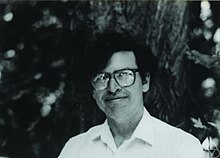William Thurston
| William Thurston | |
|---|---|

William Thurston in 1991
|
|
| Born | William Paul Thurston October 30, 1946 Washington, D.C., United States |
| Died | August 21, 2012 (aged 65) Rochester, New York, United States |
| Nationality | American |
| Fields | Mathematics |
| Institutions |
Cornell University University of California, Davis Mathematical Sciences Research Institute University of California, Berkeley Princeton University |
| Alma mater |
New College of Florida University of California, Berkeley |
| Doctoral advisor | Morris Hirsch |
| Doctoral students |
Richard Canary Benson Farb David Gabai William Goldman Steven Kerckhoff Yair Minsky Igor Rivin Oded Schramm Richard Schwartz Danny Calegari |
| Known for |
Thurston's geometrization conjecture Thurston's theory of surfaces Milnor–Thurston kneading theory |
| Notable awards |
Fields Medal (1982) Oswald Veblen Prize in Geometry (1976) National Academy of Sciences (1983) Leroy P. Steele Prize (2012). |
William Paul Thurston (October 30, 1946 – August 21, 2012) was an American mathematician. He was a pioneer in the field of low-dimensional topology. In 1982, he was awarded the Fields Medal for his contributions to the study of 3-manifolds. From 2003 until his death he was a professor of mathematics and computer science at Cornell University.
His early work, in the early 1970s, was mainly in foliation theory, where he had a dramatic impact. His more significant results include:
In fact, Thurston resolved so many outstanding problems in foliation theory in such a short period of time that it led to a kind of exodus from the field, where advisors counselled students against going into foliation theory because Thurston was "cleaning out the subject" (see "On Proof and Progress in Mathematics", especially section 6 ).
His later work, starting around the mid-1970s, revealed that hyperbolic geometry played a far more important role in the general theory of 3-manifolds than was previously realised. Prior to Thurston, there were only a handful of known examples of hyperbolic 3-manifolds of finite volume, such as the Seifert–Weber space. The independent and distinct approaches of Robert Riley and Troels Jørgensen in the mid-to-late 1970s showed that such examples were less atypical than previously believed; in particular their work showed that the figure-eight knot complement was hyperbolic. This was the first example of a hyperbolic knot.
Inspired by their work, Thurston took a different, more explicit means of exhibiting the hyperbolic structure of the figure-eight knot complement. He showed that the figure-eight knot complement could be decomposed as the union of two regular ideal hyperbolic tetrahedra whose hyperbolic structures matched up correctly and gave the hyperbolic structure on the figure-eight knot complement. By utilizing Haken's normal surface techniques, he classified the incompressible surfaces in the knot complement. Together with his analysis of deformations of hyperbolic structures, he concluded that all but 10 Dehn surgeries on the figure-eight knot resulted in irreducible, non-Haken non-Seifert-fibered 3-manifolds. These were the first such examples; previously it had been believed that except for certain Seifert fiber spaces, all irreducible 3-manifolds were Haken. These examples were actually hyperbolic and motivated his next revolutionary theorem.
...
Wikipedia
